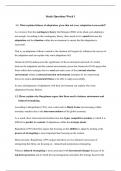Study Questions Week 1
1.1. What explains failures of adaptation, given that not every adaptation is successful?
As we know from the contingency theory that Morgan (2006) wrote about, just adapting is
not enough. According to this contingency theory, there needs to be a match between the
adaptation and the situation within the environment to ensure that the adaptation is
successful.
That is, an adaptation without a match to the situation will negatively influence the success of
the adaptation and can explain why some adaptations fail.
Abatecola (2014) underscores this significance of the environment and need of a match
between the adaptation and the external environment, given that Abatecola (2014) argues that
firms within their strategies have to read and make sense of the external selection
environment within its internal selection environment (interplay by two intertwined
forces) to ensure environmental fitness to be able to adapt successfully.
In sum, misalignment of adaptations with their environment can explain why some
adaptations become failures.
1.2. Please explain why Burgelman argues that firms need to balance autonomous and
induced strategizing.
According to Burgerlman (1991), rare events such as Black Swans are increasing within
nowadays markets due to the interconnectedness of the global economy.
As a result, these interconnected markets turn into hyper competitive markets in which it is
difficult to predict the content of adaptations within the strategic intent.
Burgelman (1991) therefore argues that focusing on the abilities to adapt by looking at the
process of strategizing is more important than focusing on the content.
More precisely, Burgerlman (1991) argues that there are two distinctive processes of
strategizing that firms can focusing on - induced and autonomous strategizing.
Whereas induced strategizing is more associated with incremental changes because of its
top-down processes and in which the top-management articulates the strategy based on the
, firms’ existing competencies within the scope of the current strategy (narrow objectives),
autonomous strategizing is more associated with radical innovations because of its
bottum-up process (not the top-management team that articulates the strategy) and focus
outside of the scope of the existing strategy (less pre-defined objectives).
That is, Burgelman (1991) argues that firms, especially within now-adays hyper competitive
markets, can increase its variation by focusing on autonomous strategizing processes to
increase its novel idea generation.
Burgelman (1991), however, argues for a balanced strategizing process, since increasing
variation by autonomous strategizing processes on itself does not come up with novel ideas
that are actually useful for the firm.
More precise, Burgelman (1991) argues that firms also need to engage in induced strategizing
processes because firms also need to generate ideas that are more closely related to its
competencies and capabilities to prevent the firm from coming up with adaptations and
strategies that are straying too far from its past success to ensure current viability.
1.3. Please identify the conditions under which a routine will experience incremental
change, radical change, or rupture (the routine breaks).
Feldman and Pentland (2003), as opposed to research that argues that routines are stable,
belief that routines are somewhat malleable and can be adapted since, although resources are
stable and persistent, people can decide to act in line with the routine or not (agency).
That is, we can look at from learning and changing routines from two perspectives.
If we built on the deterministic perspective of prior research, routines are seen as stable and
cannot be adapted. Hence, routines will experience radical change – or even rupture – at the
moment that the environment has changed, since this misalignment will cause huge stress
between the routines and environment, leading towards replacement and radical adaptation
of the routines to ensure alignment with the environment (punctuated change).
If we built on the voluntaristic perspective of Feldman and Pentland, routines are seen as
malleable and can be constantly and slightly adapted. Hence, routines will experience
incremental change at the moment that the environment starts changing since the routines
will be change by small adjustments to ensure alignment step for step (gradual change).




